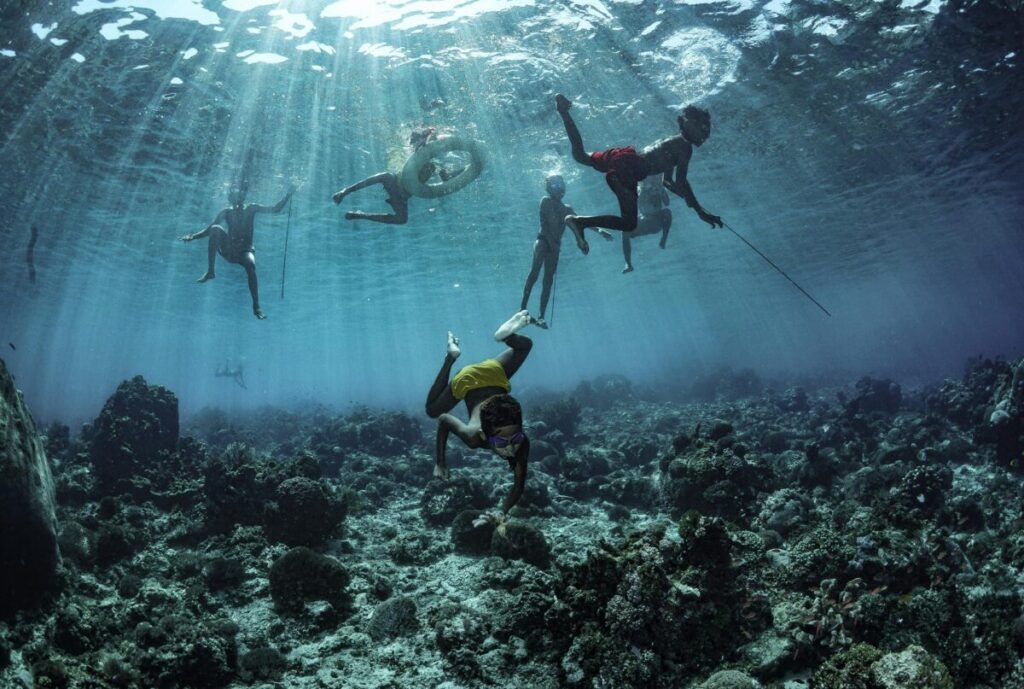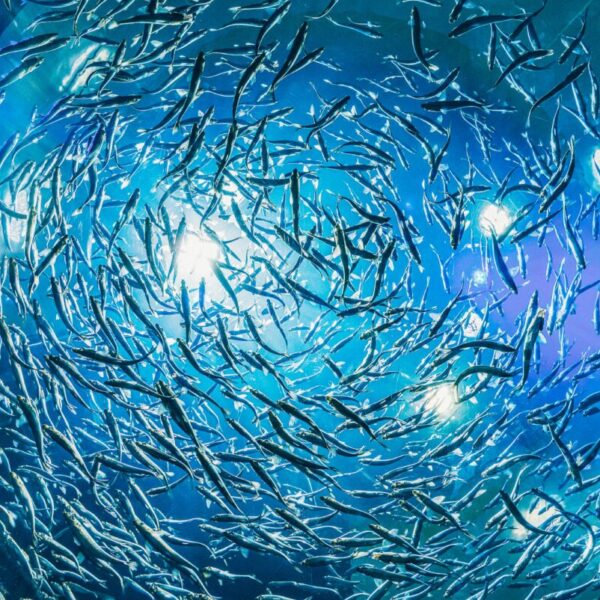One month before the third United Nations Ocean Conference (UNOC 3), which will be held in Nice from June 9 to 13, 2025, international mobilization for the protection of marine environments takes on particular importance. And the Mediterranean illustrates the crucial stakes of this meeting. Today, it is severely threatened by human activities, overfishing, pollution, invasive species, and climate change, and its biodiversity is becoming increasingly scarce. To halt this spiral, various regional and international initiatives have been established to preserve marine ecosystems and promote sustainable management of these resources.
By Caroline Haïat
Several species have been classified as critically endangered by the International Union for Conservation of Nature (IUCN). One example is the angel shark—a flat-bodied shark often mistaken for a ray—that hides in the sandy seabeds of the Mediterranean. Its population has plummeted by over 80% in the past 45 years, mainly due to accidental capture in bottom trawling. Another case is the spiny lobster, a shy crustacean found in coral reefs. While it's protected in most Mediterranean countries, illegal fishing still threatens its survival, with nearly two tons caught annually off the coast of Israel. To combat this, a mobile app developed by the Society for the Protection of Nature in Israel (SPNI) now allows the public to report such violations.
“Native species like sea urchins, mollusks, and snails are also under threat, both from climate change and invasive species,” says Dr. Gil Rilov, a researcher at the Israel Oceanographic and Limnological Research Institute.
“Sea turtles, though protected, still face many dangers. Artificial lights from coastal areas often disorient them, leading them toward land instead of the sea. As a result, around 3,000 turtles are caught each year in fishing nets or on hooks. That’s why SPNI has launched awareness campaigns and created the Sea Watch app, which enables citizens to report dangers they encounter,” he adds.
Numerous marine areas have been declared protected zones—off the coast of Tel Aviv, for instance, where rare corals, squid, and sharks can be found. The Bonifacio Strait in Corsica (France) is rich in Posidonia seagrass and home to dolphins. The Medes Islands in Catalonia are renowned for their exceptional biodiversity. In Greece, loggerhead turtles nest in Zakynthos National Park. Elsewhere, the Pelagos Sanctuary, shared by France, Corsica, and Italy, protects numerous cetacean species, while the waters surrounding the Maltese archipelago draw attention for their underwater caves and endemic marine life.
Real threats to biodiversity in the Mediterranean
Israel has recorded 452 invasive marine species along its coasts, most arriving from the Red Sea via the Suez Canal. But this isn’t just a local issue. The Mediterranean—one of the most fragile marine ecosystems in the world—is experiencing a growing invasion of non-native species. The phenomenon, often referred to as the "Suez Canal invasion," affects the entire region. Species like lionfish, Caulerpa algae, and the Suez crab are spreading rapidly, disrupting ecosystems and threatening sectors such as fishing and tourism.
Efforts to monitor and manage these invasive species are increasing, but the challenges remain significant. Pollution, overfishing, and unchecked coastal development continue to degrade habitats and reduce biodiversity. In response, numerous initiatives have emerged.
Israel, for example, is stepping up enforcement and environmental monitoring. “Israeli institutions are working with international partners to track the health of marine ecosystems. New technologies like environmental DNA allow us to detect the presence of species and measure biodiversity without disturbing natural habitats,” explains Dr. Rilov.
A large-scale regional and international cooperation
The Blue Plan, in partnership with the PANACeA project (Streamlining Networking and Management efforts in Mediterranean Protected Areas for Enhanced Natural Conservation and Protection), has helped improve the management of marine protected areas (MPAs) in southern Mediterranean countries. The initiative focused on strengthening governance, fostering public-private partnerships, and enhancing ecosystem services to support biodiversity.
Following PANACeA (2019–2022), the Mediterranean Biodiversity Protection Community (MBPC) took over. It continues to encourage cooperation between public and private stakeholders, promote sustainable management models, and develop tools tailored to the unique challenges of Mediterranean MPAs. The MBPC also supports national and regional strategies for better governance and more coherent management of protected zones, encouraging cross-sector collaboration.
A notable success is the Port-Cros MPA in France, where public-private partnerships have led to better biodiversity monitoring and sustainable management practices. In Greece, joint efforts by scientists and local authorities have helped restore fish populations in Zakynthos National Park, an important nesting site for sea turtles.
The MBPC places strong emphasis on participatory governance. In the Tavolara-Punta Coda Cavallo area in Sardinia, Italy, management involves local fishers, tourism operators, scientists, and residents. This inclusive approach has led to improved marine habitats, wider acceptance of protection rules, and positive economic outcomes from eco-tourism and sustainable fishing.
Science in Action
The General Fisheries Commission for the Mediterranean has launched a 10-year action plan to reconcile fishing practices with marine biodiversity conservation. Pilot programs in Morocco, Tunisia, and Turkey are testing ways to reduce bycatch and promote sustainable fisheries.
In response to the spread of invasive species, some initiatives aim to turn threats into opportunities. In Tunisia, for instance, the government encourages the marketing of the invasive blue crab—helping local fishers while controlling its population.
Six major international organizations—including the IUCN and MedPAN (Mediterranean Protected Areas Network)—have joined forces to protect Mediterranean biodiversity. Their collaboration focuses on identifying nature-based solutions, mobilizing communities, and strengthening environmental governance.
Scientific missions also play a key role. One such project, Noah’s Ark of the Depths, launched in October 2022 by the 1 Ocean Foundation with UNESCO and CNRS, studies the impact of climate change on iconic marine species like red gorgonians. These efforts are helping to shape conservation strategies adapted to current and future climate challenges in the Mediterranean.

Featured Photo: the protection of marine environments takes on crucial importance © DR
